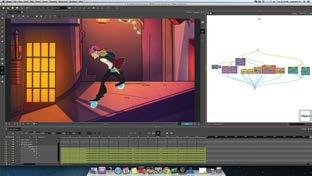previous page
ISSUE
TOC
250
V isual E ffects
Looking Back to the Future Visual-effects artists evoke yesteryear’s optimistic view of the future for director Brad Bird’s Tomorrowland. By Bill Desowitz.
W
alt Disney envisioned Tomorrowland — an original Disneyland attraction that opened in 1955 — as an inspiring and optimistic vision of the future, full of sweeping towers, clean open spaces and life-improving conveniences science could only hint at. But in turning that vision into the feature film Tomorrowland, which hit theaters May 22 from Disney, it was the contrast provided by later years’ pessimism and darker visions of the future that appealed to director Brad Bird, writer-producer Damon Lindelof and star George Clooney. To bring the visuals of the story to life, the filmmakers tasked ILM with creating the landscape of Tomorrowland, which incorporated Disney’s Experimental Prototype Community of Tomorrow, or EPCOT, idea of urban planning as well as a recreation of much of the 1964 New
York World’s Fair, where Disney premiered “It’s a Small World,” along with “The Carousel of Progress,” the animatronic attraction “Great Moments with Mr. Lincoln” and the famous PeopleMover. ILM worked on the pavilions, set pieces and set extensions of the World’s Fair, which was comprised of full CG environments. “Brad had a real affinity for the World’s Fair, that stylized 1964 look,” says Eddie Pasquarello (The Avengers), visual-effects co-supervisor with Craig Hammack (Star Trek) on Tomorrowland. “He was very articulate about matching the World’s Fair and we knew where we had to go.” The movie is about a scientifically curious and optimistic teen played by Britt Richardson who learns Tomorrowland is real and tracks down Clooney’s Frank Walker to reach it. The movie also features Hugh Laurie as the brilliant villain
David Nix, and required three different visions of Tomorrowland: a 1964 version, a 1984 version and a dystopian future version, each of which required its own flavor.
Seeing Triple
“For Tomorrowland, he really wanted to convey a mood in each of the three experiences,” says Pasquarello. “While it’s under construction in 1964, it needed to have a certain optimism to it. Years went into the planning with architects and ILM, and it truly was a city planning adventure. Brad had a hand in the layout and where buildings were placed.” The idealized Tomorrowland has large fountain, sprawling grassy areas and curvaceous architecture that is shiny and eco-friendly. The main area is Bridgeway Plaza, which contains a tower that’s the centerpiece of Tomorrowland.
84 www.animationmagazine.net june 15
TOC
previous page


















